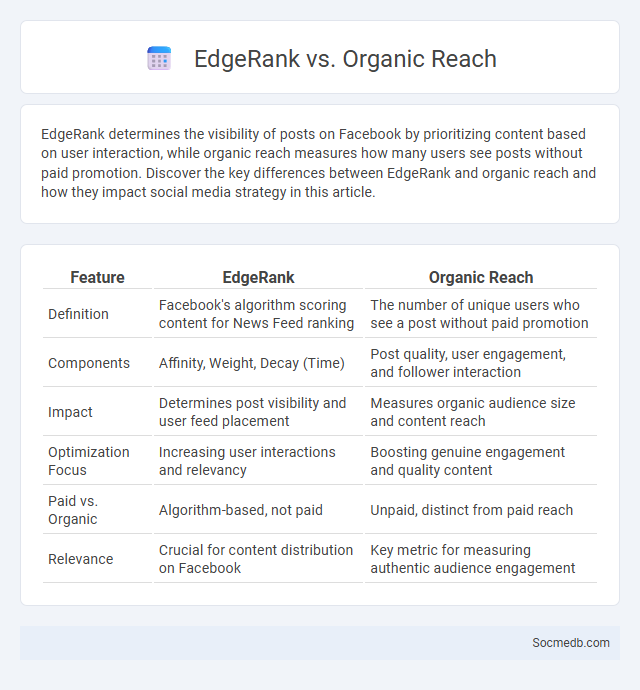
Photo illustration: EdgeRank vs Organic Reach
EdgeRank determines the visibility of posts on Facebook by prioritizing content based on user interaction, while organic reach measures how many users see posts without paid promotion. Discover the key differences between EdgeRank and organic reach and how they impact social media strategy in this article.
Table of Comparison
| Feature | EdgeRank | Organic Reach |
|---|---|---|
| Definition | Facebook's algorithm scoring content for News Feed ranking | The number of unique users who see a post without paid promotion |
| Components | Affinity, Weight, Decay (Time) | Post quality, user engagement, and follower interaction |
| Impact | Determines post visibility and user feed placement | Measures organic audience size and content reach |
| Optimization Focus | Increasing user interactions and relevancy | Boosting genuine engagement and quality content |
| Paid vs. Organic | Algorithm-based, not paid | Unpaid, distinct from paid reach |
| Relevance | Crucial for content distribution on Facebook | Key metric for measuring authentic audience engagement |
Introduction: Understanding EdgeRank and Organic Reach
EdgeRank is the algorithm Facebook uses to determine which content appears in a user's News Feed, influencing your organic reach by prioritizing posts based on relevance and engagement. It factors in user affinity, content weight, and time decay to rank posts, ensuring more meaningful interactions are shown first. Understanding how EdgeRank works is essential for optimizing your social media strategy and increasing visibility without paid promotion.
What is EdgeRank?
EdgeRank is the algorithm Facebook uses to determine which posts appear in your News Feed by ranking content based on three main factors: affinity, weight, and time decay. Affinity measures your relationship with the content creator, weight considers the type of interaction (likes, comments, shares), and time decay favors newer posts to keep your feed relevant. Understanding EdgeRank helps you optimize your social media strategy to increase visibility and engagement on your posts.
Evolution of EdgeRank: From Formula to Algorithm
EdgeRank, initially a simple formula used by Facebook to prioritize news feed content, has evolved into a sophisticated algorithm incorporating multiple factors such as user engagement, content type, and recency. This transition reflects social media's shift towards personalized user experiences driven by machine learning, resulting in dynamic content delivery tailored to individual preferences. Continuous updates to the EdgeRank algorithm now leverage AI to analyze user behavior patterns, enhancing relevance and increasing user retention on social platforms.
How EdgeRank Influences Organic Reach
EdgeRank, Facebook's algorithm, determines organic reach by prioritizing content based on affinity, weight, and time decay. High-affinity interactions between users and pages increase the likelihood of content appearing in users' newsfeeds, while content types with more engagement, such as videos and comments, carry greater weight. Time decay reduces visibility of older posts, encouraging timely, relevant content to maximize organic reach.
Differences Between EdgeRank and Organic Reach
EdgeRank is Facebook's algorithm designed to prioritize content in users' News Feeds based on factors like affinity, weight, and time decay, determining which posts users see first. Organic reach refers to the number of unique users who see a post without paid promotion, heavily influenced by EdgeRank's ability to rank and distribute content. While EdgeRank controls the visibility frequency and order of content, organic reach reflects actual audience exposure, with algorithm changes often causing fluctuations in organic reach rates.
The Decline of Organic Reach on Facebook
Facebook's organic reach has significantly declined, with average post visibility dropping to below 5% for most Pages. Algorithm changes prioritize paid content and meaningful interactions, reducing the exposure of unpaid posts in users' News Feeds. This trend compels brands to increase advertising budgets and develop more engaging content strategies to maintain audience engagement.
Factors Affecting Organic Reach Beyond EdgeRank
Factors affecting organic reach on social media extend beyond Facebook's EdgeRank algorithm, including content relevance, audience engagement, posting frequency, and timing. Platform-specific changes such as algorithm updates on Instagram and Twitter prioritize meaningful interactions, video content, and user preferences. Understanding these variables enables marketers to optimize content strategies for increased visibility and organic user reach.
Myths and Facts: Is EdgeRank Still Relevant?
EdgeRank, once Facebook's primary algorithm for content visibility, has evolved significantly into a more complex system prioritizing user engagement and relevance. Many believe EdgeRank is obsolete, but its core principles--affinity, weight, and time decay--still influence how your posts are ranked. Understanding these fundamentals helps you optimize content effectively in today's social media landscape.
Optimizing Content for Better Organic Reach
Optimizing your social media content involves using relevant keywords, engaging visuals, and tailored hashtags to increase visibility and attract your target audience. Creating authentic and shareable posts encourages more organic interactions, boosting your reach without paid promotion. Regularly analyzing platform-specific algorithms helps you refine your strategy for maximum engagement and sustainable growth.
Conclusion: Navigating Facebook’s Ever-Changing Algorithm
Understanding Facebook's ever-changing algorithm requires continuous adaptation to its focus on meaningful interactions and personalized content delivery. Content creators must prioritize authentic engagement by producing relevant, high-quality posts that resonate with specific audience segments. Leveraging data analytics to track performance metrics ensures strategic adjustments that align with evolving algorithmic preferences, maximizing reach and impact.
 socmedb.com
socmedb.com